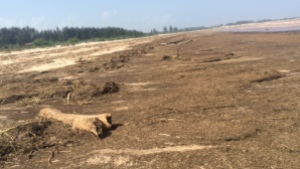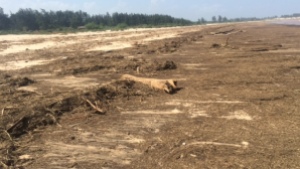
A walk along the Kenyan Coastal beach at Malindi will reveal the adversities of El Nino and hence climate change. I couldn’t believe my eyes seeing all the trash from upcountry that have been swept to the sea through the Sabaki Estuary and scattered along several kilometres of the beach by the powerful ocean waves. I am used to the white sandy beach but what confronted me was dark thick layers of debris scattered the entire beach area.

The key question to ask is, where did this trash came from? Scientific evidence shows that the rivers emptying in the ocean come from upcountry especially Mount Kenya region, Nairobi and Ukambani region. Hence these are the regions that are responsible for littering our beaches as a result of El Nino. Surprisingly this deposited litter has led to formation of new land mass, all that beach front you see on the pictures is new. Hence Central and Eastern Kenya could claim a piece of the coastal zone (if only the soil particles could speak and say where they originated from. Tonnes of their top fertile soil have been eroded and deposited in the Indian Ocean and established the new found land.

Its important to note that the Sabaki Estuary is several kilometers away and seeing scattered debris of such thickness is evidence that tonnes of debris was carried downstream. If you observe the estuary area from the sky, the water is brown in color with suspended soil particles. The soil depicts that it originates from volcanic rocks of Mt Kenya region and Eastern Kenya.

From the pictures scattered on this page, it is evident that the El Nino phenomena wrecked havok wherever it passed. If the water could uproot whole trees, bananas and heavy boulders, what could have happened to our fertile top soil in the farms where the water passed? Definitely, it was all carried downstream, leaving behind very impoverished soils, which will in the next few months lead to declined food security, hunger and poverty.

Rarely do we consider the holistic losses emanating from a simple phenomenon like El Nino. We are normally very preoccupied with preventing loss of life and adapting to the aftermath of the deluge through rehabilitation of damaged infrastructure. But the costs from El Nino are major and negatively impact the country’s sustainable development. I’d wish to discuss briefly these impacts within the three pillars of sustainable development namely environmental, social and economic pillars.

At the environmental front, El Nino is responsible for flooding, erosion of top soil, spread of water related diseases such as cholera and malaria among others. Due to siltation of water, some people are left with no quality water for their use and hence there is lack of water. The flooded areas harbor some species of organisms that cannot tolerate waterlogging and they die while plants dry up.

On the social front, El Nino is responsible for deaths and displacement of populations. Flooding blocks members of the community from accessing essential facilities such as schools, hospitals and other social amenities. Some cultural activities cannot take place due to adversities of El Nino.

Economically, El Nino is responsible for loss of jobs and money. Damage to infrastructure, homes, farms, death of livestock, decrease of working hours due to disease, and poverty among others cannot be overemphasized. These losses are normally tabulated into millions of dollars.

With the many plans that were put in place to counter the impacts of El Nino, very little was said about loss of top soil. Besides loss of life, this is the second most expensive cost of El Nino which calls for a proactive approach to address it. The El Nino effect will be over soon but the impact will live with us a little longer. We will soon experience poor harvests, hunger and poverty.

The same vigor and preparedness we demonstrated when we waited for El Nino should be turned to reducing the impacts of the next El Nino. Let it not carry any more vegetation and top soil to the ocean. Let us ensure that we invest in saving our top soil which takes thousands of years to develop through natural weathering process.

Some of the investments needed now include
1. Planting trees along the catchment areas to hold the soil together and to reduce impact of raindrops on the ground and enhance percolation of rainwater to the ground.
2. Building of water holding reservoirs to harvest the rain water as well as to reduce the eroding power of the El Nino.
3. Ensure our wetlands (swamps, lakes, bogs) are protected to act as trapping grounds for this excess water as well as to filter any eroded fertile soil so that we don’t lose it to the ocean.
4. Public awareness for people to understand the negative and costly effects of El Nino and their responsibility in addressing the challenge from a long term perspective.
Hence, let us not stop anticipating El Nino but let us make every day an intervention day to reduce future impacts of the menace.
Article Categories:
Education for Sustainable Development (ESD)